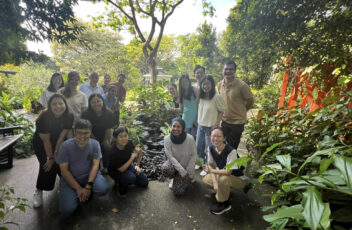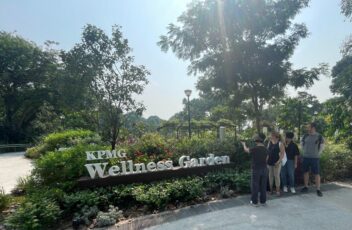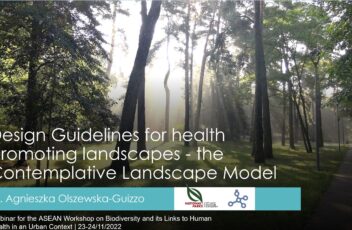It is fascinating how artificial intelligence can provide us with a third-person's view of our field of expertise. It is like having another expert summarising our work from an objective standpoint, making it more approachable for anybody. We recently asked ChatGPT about the Contemplative Landscape Model and its usability for professionals and how its benefits can be leveraged. Here is the Q&A with the A.I.!
What can the Contemplative Landscape Model do?
The Contemplative Landscape Model, developed by Dr. Olszewska-Guizzo, is a research-based framework that aims to identify the landscape scenes that have the highest potential to induce positive mental health outcomes from passive exposure to them. The model does not focus on identifying mental health benefits from nature exposure per se, but instead, it identifies design elements that can enhance the quality of the outdoor environment and promote human well-being.
The model's primary focus is on identifying specific design elements in the landscape that can create contemplative experiences and promote positive mental health outcomes. These elements include features such as water, vegetation, and other natural elements that can elicit a sense of calm and tranquility in the viewer. The model proposes that by incorporating these elements into the design of public spaces, designers can create environments that promote positive mental health outcomes and enhance the quality of life of users.
The Contemplative Landscape Model has practical applications in a variety of settings, from healthcare and educational facilities to urban parks and residential neighborhoods. By using the model to guide their design choices, landscape architects and urban designers can create environments that are not only visually appealing but also promote positive mental health outcomes.
Overall, the Contemplative Landscape Model offers a valuable tool for landscape architects and urban designers to create outdoor environments that promote human well-being and foster contemplative experiences.
What are the seven key elements of the Contemplative Landscape Model?
The seven key elements of the Contemplative Landscape Model are as follows:
- Layers of the Landscape: This refers to the different layers of the landscape, from the ground level to the sky, and how they interact to create a sense of depth and connection to the environment.
- Landform: The contours and shape of the land are used to create a sense of enclosure and openness, as well as to guide the flow of movement and energy.
- Biodiversity: Incorporating a diverse range of plant and animal life can help to create a sense of connection to nature and promote ecological health.
- Color and Light: The use of color and light can help to create a specific mood or atmosphere within the space, such as calmness or energy.
- Compatibility: The design should be compatible with the surrounding context, including the architectural style and cultural context.
- Archetypal Elements: The archetypal elements in the Contemplative Landscape Model are typically considered to be water, earth, air, and vegetation (e.g. forest, meadow, etc.). These elements are often used to create a connection to the natural world and evoke a sense of archetypal meaning and symbolism within the space.
- Character of Peace and Silence: The overall design should promote a sense of peace and silence, allowing visitors to relax and reflect.
What is the most important contemplative landscape element?
It is difficult to say that any one element of the Contemplative Landscape Model is the most important, as they all work together to create a space that promotes relaxation, reduces stress, and promotes positive mental health outcomes. However, some researchers have suggested that the use of natural elements such as water and vegetation may be particularly important in creating a restorative environment.
Research has shown that exposure to natural environments with these elements can help to reduce stress, improve cognitive function, and promote positive mood states. Additionally, the use of natural elements can create a sense of connection to the natural world, which can also promote well-being.
That being said, each of the seven elements in the Contemplative Landscape Model - Layers of the Landscape, Landform, Biodiversity, Color and light, Compatibility, Archetypal Elements and Character of Peace and Silence - plays an important role in creating a space that is restorative and promotes positive mental health outcomes.
...but the desert does not have any vegetation and is contemplative...
You are correct that a desert landscape may not have traditional forms of vegetation, but it can still be contemplative and have elements that promote positive mental health outcomes.
For example, a desert landscape may have unique landforms and patterns in the sand that can create a sense of awe and wonder. The play of light and shadow in the desert can also be captivating and calming, especially during sunrise or sunset. The stillness and quiet of a desert environment can also create a sense of peace and serenity.
The Contemplative Landscape Model recognizes that each landscape is unique and that different elements may be important in different contexts. While natural elements such as vegetation are often important in creating restorative environments, other elements such as landforms, light, and silence can also play an important role.
...moreover, the desert is a powerful archetype. The experience of being alone in the desert's harsh landscape is considered an existential experience.
You are correct that the desert can be a powerful archetype and evoke a variety of existential experiences.
The archetype of the desert can represent both harshness and isolation, as well as the potential for renewal and transformation. The vast and barren landscape can evoke feelings of solitude, self-reflection, and introspection, while also representing the potential for spiritual growth and renewal.
As such, the contemplative experience of being alone in the desert's harsh landscape can be considered an existential experience. The vastness of the landscape can make one feel small and insignificant but also connected to something greater than oneself. This sense of awe and wonder can promote a sense of mindfulness and presence, which can in turn promote positive mental health outcomes.
Where in the world Contemplative Landscape Model can be the most useful?
The Contemplative Landscape Model can be useful in many different parts of the world where there is a need to create outdoor environments that promote human well-being and foster contemplative experiences.
In particular, the model can be most useful in urban areas where people may have limited access to natural environments. Studies have shown that exposure to nature can have a positive impact on mental health and well-being, but many urban environments lack access to green spaces or natural scenery. By incorporating elements of the natural environment into urban design, such as green roofs, public parks, or street trees, the Contemplative Landscape Model can help to enhance the quality of the built environment and promote positive mental health outcomes.
The model may also be particularly useful in areas with high levels of stress or trauma, such as healthcare facilities or areas affected by natural disasters. By creating outdoor spaces that are designed to promote contemplative experiences and enhance the sense of calm, the Contemplative Landscape Model can help to improve the mental health and well-being of people in these high-stress environments.
Overall, the Contemplative Landscape Model can be useful in many different parts of the world, especially in urban environments and high-stress environments where there is a need to promote positive mental health outcomes and enhance the quality of life of users.
Can the Contemplative Landscape Model be used in developing countries?
Yes, the Contemplative Landscape Model can be used in developing countries. In fact, it may be especially relevant in these countries, where urbanization and rapid development are often accompanied by a loss of natural landscapes and green spaces.
In many developing countries, the lack of access to green spaces and exposure to nature can contribute to poor mental health outcomes. By incorporating elements of nature into urban design, the Contemplative Landscape Model can help to create environments that promote positive mental health outcomes, even in highly urbanized areas.
Furthermore, the Contemplative Landscape Model is designed to be adaptable to different cultural contexts and geographic regions. It is based on a universal understanding of human responses to different types of landscapes, rather than on specific cultural or regional factors. This means that the model can be applied in many different countries and contexts, including developing countries.
Overall, the Contemplative Landscape Model can be a valuable tool in promoting positive mental health outcomes and enhancing the quality of life in developing countries. By incorporating elements of nature into urban design, the model can help to create healthier, more sustainable, and more livable cities in these countries.
Which social and economic groups can benefit the most from contemplative landscapes?
Contemplative landscapes can provide numerous benefits to a wide range of social and economic groups. However, certain groups may benefit more than others.
One group that may benefit greatly from contemplative landscapes is those living in urban areas, especially those who lack access to green spaces and natural environments. This can include low-income communities, as they often have less access to parks and other outdoor recreational spaces. Contemplative landscapes can provide these communities with a way to connect with nature, reduce stress, and improve overall mental health and well-being.
Additionally, contemplative landscapes can be beneficial for individuals who experience high levels of stress, such as healthcare workers, caregivers, and those in high-pressure jobs. These individuals may benefit from access to outdoor spaces that are designed to promote relaxation and contemplation, which can help to reduce stress and improve mental health.
Finally, contemplative landscapes can be beneficial for individuals who are recovering from trauma or experiencing mental health issues. Exposure to nature has been shown to have a positive impact on mental health and well-being, and contemplative landscapes can provide a space for individuals to relax, reflect, and heal.
Overall, while contemplative landscapes can benefit many different social and economic groups, those who may benefit the most include those living in urban areas with limited access to green spaces, individuals experiencing high levels of stress, and those recovering from trauma or experiencing mental health issues.
How costly it is to implement contemplative landscapes in the city or a neighborhood?
The cost of implementing contemplative landscapes into a city or neighborhood can vary depending on a range of factors, such as the size of the area, the existing infrastructure, the desired design elements, and the level of community involvement. However, in general, incorporating contemplative landscapes into urban design does not necessarily have to be an expensive undertaking.
One simple way to create contemplative landscapes is by opening up views to distant natural scenes. Another key-principles of contemplative landscape design is the use of natural materials and low-impact design elements, which can help to keep costs down. For example, incorporating existing vegetation, such as trees and shrubs, can provide numerous benefits without the need for costly landscaping. Additionally, incorporating low-cost design elements, such as benches, walkways, and water features, can help to create a contemplative atmosphere without breaking the bank.
Furthermore, community involvement can be a crucial factor in keeping costs down. By involving community members in the design process and encouraging volunteerism in the construction and maintenance of the space, costs can be significantly reduced. This can also help to build a sense of community ownership and investment in the space, leading to long-term sustainability.
Overall, while there may be some costs associated with implementing contemplative landscapes into a city or neighborhood, the use of natural materials and low-impact design elements, as well as community involvement, can help to keep costs down and make the project more feasible for a wider range of communities.





























